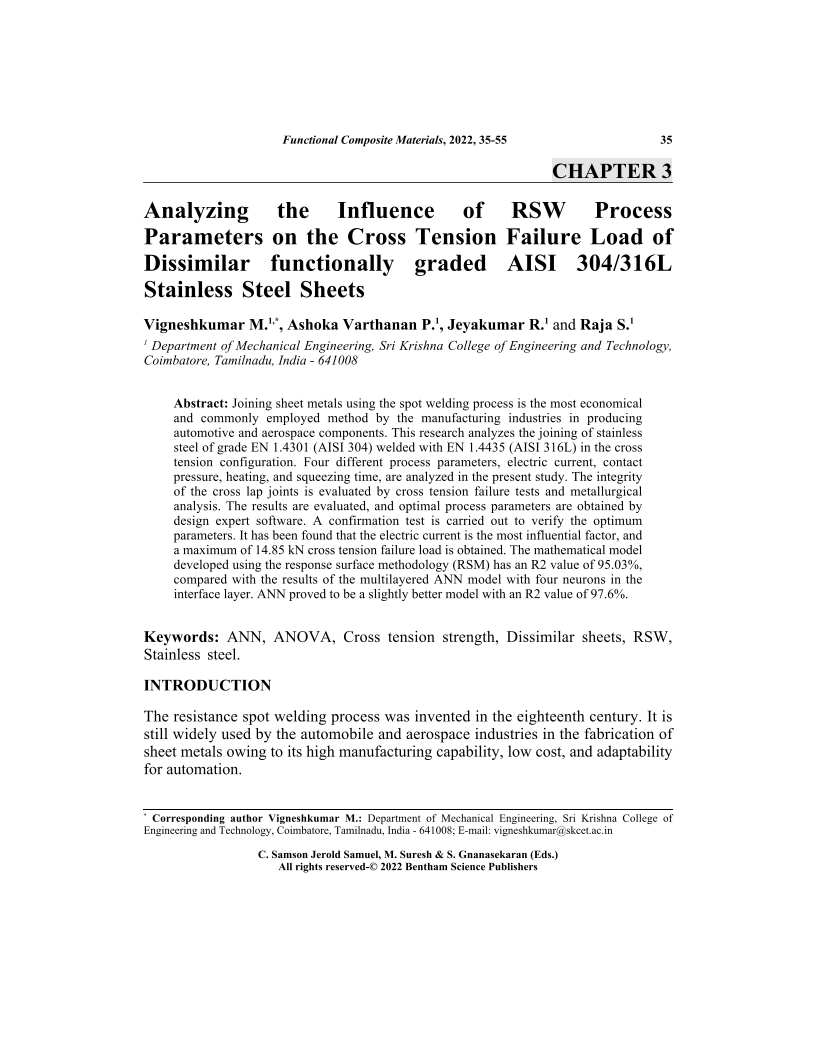Analyzing the Influence of RSW Process Parameters on the Cross Tension Failure Load of Dissimilar functionally graded AISI 304/316L Stainless Steel Sheets

- Authors: Vigneshkumar M.1, Ashoka Varthanan P2, Jeyakumar R.3, Raja S.4
-
View Affiliations Hide Affiliations1 Department of Mechanical Engineering, Sri Krishna College of Engineering and Technology,Coimbatore, Tamilnadu, India 641008 2 Department of Mechanical Engineering, Sri Krishna College of Engineering and Technology,Coimbatore, Tamilnadu, India - 641008 3 Department of Mechanical Engineering, Sri Krishna College of Engineering and Technology, Coimbatore, Tamilnadu, India - 641008 4 Department of Mechanical Engineering, Sri Krishna College of Engineering and Technology, Coimbatore, Tamilnadu, India - 641008
- Source: Functional Composite Materials: Manufacturing Technology and Experimental Application , pp 35-55
- Publication Date: April 2022
- Language: English
Analyzing the Influence of RSW Process Parameters on the Cross Tension Failure Load of Dissimilar functionally graded AISI 304/316L Stainless Steel Sheets, Page 1 of 1
< Previous page | Next page > /docserver/preview/fulltext/9789815039894/chap3-1.gif
Joining sheet metals using the spot welding process is the most economical and commonly employed method by the manufacturing industries in producing automotive and aerospace components. This research analyzes the joining of stainless steel of grade EN 1.4301 (AISI 304) welded with EN 1.4435 (AISI 316L) in the cross tension configuration. Four different process parameters, electric current, contact pressure, heating, and squeezing time, are analyzed in the present study. The integrity of the cross lap joints is evaluated by cross tension failure tests and metallurgical analysis. The results are evaluated, and optimal process parameters are obtained by design expert software. A confirmation test is carried out to verify the optimum parameters. It has been found that the electric current is the most influential factor, and a maximum of 14.85 kN cross tension failure load is obtained. The mathematical model developed using the response surface methodology (RSM) has an R2 value of 95.03%, compared with the results of the multilayered ANN model with four neurons in the interface layer. ANN proved to be a slightly better model with an R2 value of 97.6%.
-
From This Site
/content/books/9789815039894.chap3dcterms_subject,pub_keyword-contentType:Journal -contentType:Figure -contentType:Table -contentType:SupplementaryData105

